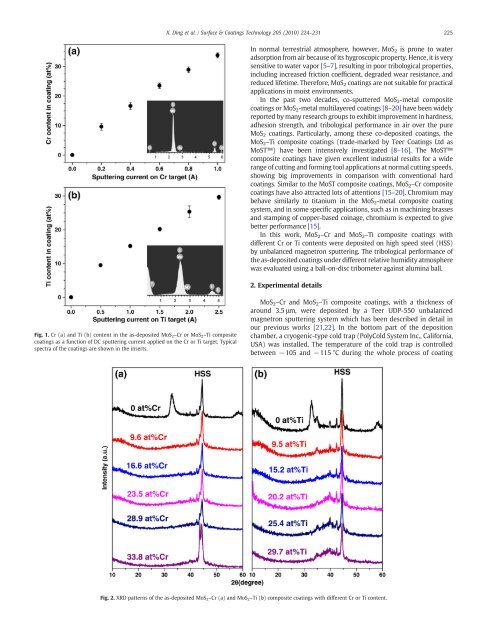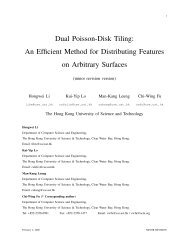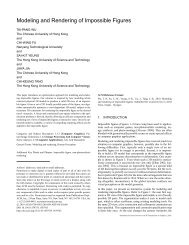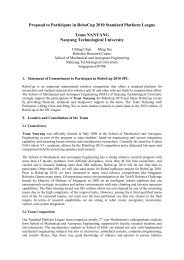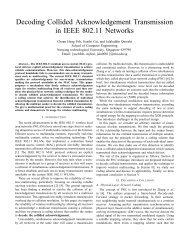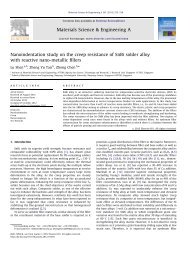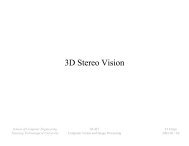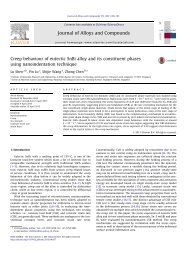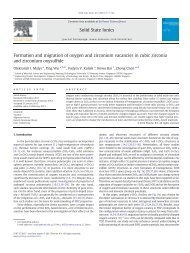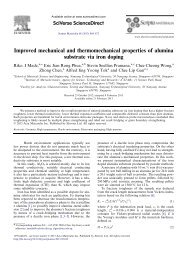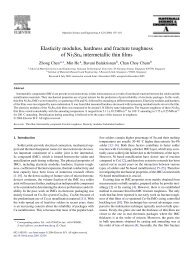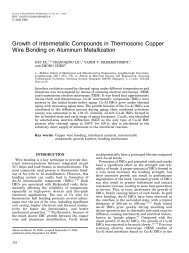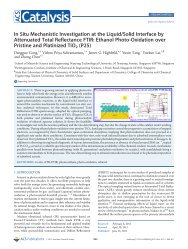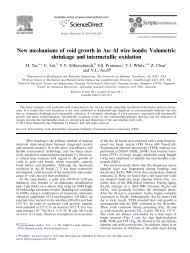and Ti-doped MoS2 composite coatings under different humidity ...
and Ti-doped MoS2 composite coatings under different humidity ...
and Ti-doped MoS2 composite coatings under different humidity ...
You also want an ePaper? Increase the reach of your titles
YUMPU automatically turns print PDFs into web optimized ePapers that Google loves.
Fig. 1. Cr (a) <strong>and</strong> <strong>Ti</strong> (b) content in the as-deposited <strong>MoS2</strong>–Cr or <strong>MoS2</strong>–<strong>Ti</strong> <strong>composite</strong><br />
<strong>coatings</strong> as a function of DC sputtering current applied on the Cr or <strong>Ti</strong> target. Typical<br />
spectra of the <strong>coatings</strong> are shown in the inserts.<br />
X. Ding et al. / Surface & Coatings Technology 205 (2010) 224–231<br />
In normal terrestrial atmosphere, however, <strong>MoS2</strong> is prone to water<br />
adsorption from air because of its hygroscopic property. Hence, it is very<br />
sensitive to water vapor [5–7], resulting in poor tribological properties,<br />
including increased friction coefficient, degraded wear resistance, <strong>and</strong><br />
reduced lifetime. Therefore, <strong>MoS2</strong> <strong>coatings</strong> are not suitable for practical<br />
applications in moist environments.<br />
In the past two decades, co-sputtered <strong>MoS2</strong>-metal <strong>composite</strong><br />
<strong>coatings</strong> or <strong>MoS2</strong>-metal multilayered <strong>coatings</strong> [8–20] have been widely<br />
reported by many research groups to exhibit improvement in hardness,<br />
adhesion strength, <strong>and</strong> tribological performance in air over the pure<br />
<strong>MoS2</strong> <strong>coatings</strong>. Particularly, among these co-deposited <strong>coatings</strong>, the<br />
<strong>MoS2</strong>–<strong>Ti</strong> <strong>composite</strong> <strong>coatings</strong> (trade-marked by Teer Coatings Ltd as<br />
MoST) have been intensively investigated [8–16]. The MoST<br />
<strong>composite</strong> <strong>coatings</strong> have given excellent industrial results for a wide<br />
range of cutting <strong>and</strong> forming tool applications at normal cutting speeds,<br />
showing big improvements in comparison with conventional hard<br />
<strong>coatings</strong>. Similar to the MoST <strong>composite</strong> <strong>coatings</strong>, MoS 2–Cr <strong>composite</strong><br />
<strong>coatings</strong> have also attracted lots of attentions [15–20]. Chromiummay<br />
behave similarly to titanium in the MoS 2-metal <strong>composite</strong> coating<br />
system, <strong>and</strong> in some specific applications, such as in machining brasses<br />
<strong>and</strong> stamping of copper-based coinage, chromium is expected to give<br />
better performance [15].<br />
In this work, MoS 2–Cr <strong>and</strong> MoS 2–<strong>Ti</strong> <strong>composite</strong> <strong>coatings</strong> with<br />
<strong>different</strong> Cr or <strong>Ti</strong> contents were deposited on high speed steel (HSS)<br />
by unbalanced magnetron sputtering. The tribological performance of<br />
the as-deposited <strong>coatings</strong> <strong>under</strong> <strong>different</strong> relative <strong>humidity</strong> atmosphere<br />
was evaluated using a ball-on-disc tribometer against alumina ball.<br />
2. Experimental details<br />
<strong>MoS2</strong>–Cr <strong>and</strong> <strong>MoS2</strong>–<strong>Ti</strong> <strong>composite</strong> <strong>coatings</strong>, with a thickness of<br />
around 3.5 μm, were deposited by a Teer UDP-550 unbalanced<br />
magnetron sputtering system which has been described in detail in<br />
our previous works [21,22]. In the bottom part of the deposition<br />
chamber, a cryogenic-type cold trap (PolyCold System Inc., California,<br />
USA) was installed. The temperature of the cold trap is controlled<br />
between −105 <strong>and</strong> −115 °C during the whole process of coating<br />
Fig. 2. XRD patterns of the as-deposited MoS 2–Cr (a) <strong>and</strong> MoS 2–<strong>Ti</strong> (b) <strong>composite</strong> <strong>coatings</strong> with <strong>different</strong> Cr or <strong>Ti</strong> content.<br />
225


